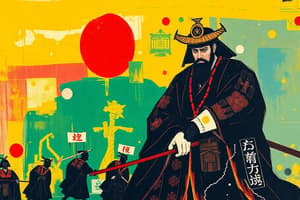Podcast
Questions and Answers
What distinguishes the Kamakura Shogunate from previous governance structures in Japan?
What distinguishes the Kamakura Shogunate from previous governance structures in Japan?
- A council of nobles jointly ruled the empire.
- Religious leaders directly controlled the political landscape.
- A military leader, the shogun, exerted real political control. (correct)
- The emperor held absolute power without military influence.
How did the Minamoto clan consolidate and maintain power during the Kamakura Shogunate?
How did the Minamoto clan consolidate and maintain power during the Kamakura Shogunate?
- By forbidding vassals from owning land.
- By equally distributing land among all social classes to ensure economic stability.
- By rewarding loyal vassals with land confiscated from former officials. (correct)
- By establishing a meritocracy where positions were earned through exams.
What role did fiefs play within the feudal system introduced by Minamoto no Yoritomo?
What role did fiefs play within the feudal system introduced by Minamoto no Yoritomo?
- Fiefs provided the economic basis for vassals to increase wealth and build armies. (correct)
- Fiefs served as communal farming lands where peasants worked together for the benefit of all.
- Fiefs were used as schools where children learned about Confucianism.
- Fiefs were properties directly managed by the shogun for the exclusive use of the imperial family.
What societal shift occurred in Japan due to the introduction of the feudal system during the Kamakura Shogunate?
What societal shift occurred in Japan due to the introduction of the feudal system during the Kamakura Shogunate?
How did the relationship between the shogun and the emperor change during the Kamakura Shogunate?
How did the relationship between the shogun and the emperor change during the Kamakura Shogunate?
What was the primary obligation of vassals to the shogun during the Kamakura Shogunate?
What was the primary obligation of vassals to the shogun during the Kamakura Shogunate?
How did the introduction of the feudal system impact the social structure of Japan?
How did the introduction of the feudal system impact the social structure of Japan?
What immediate action did Minamoto no Yoritomo take to establish the feudal system after consolidating power?
What immediate action did Minamoto no Yoritomo take to establish the feudal system after consolidating power?
What was the long-term consequence of vassals owning land within the Kamakura Shogunate's feudal system?
What was the long-term consequence of vassals owning land within the Kamakura Shogunate's feudal system?
What was the relationship between the samurai and the lords in the feudal system of the Kamakura Shogunate?
What was the relationship between the samurai and the lords in the feudal system of the Kamakura Shogunate?
Flashcards
What is a Shogunate?
What is a Shogunate?
A military system where a shogun (military leader) ruled Japan, despite the emperor still existing.
What was the Kamakura Shogunate?
What was the Kamakura Shogunate?
The era from 1192-1333 when the Minamoto clan dominated Japan from Kamakura.
Who was the Shogun?
Who was the Shogun?
The military leader who held real power in Japan during the Shogunate.
Who was the Minamoto Clan?
Who was the Minamoto Clan?
Signup and view all the flashcards
Who were the Vassals?
Who were the Vassals?
Signup and view all the flashcards
What were Fiefs?
What were Fiefs?
Signup and view all the flashcards
What is the Feudal System?
What is the Feudal System?
Signup and view all the flashcards
Who Was Minamoto no Yoritomo?
Who Was Minamoto no Yoritomo?
Signup and view all the flashcards
Who were the Samurai?
Who were the Samurai?
Signup and view all the flashcards
How did Minamoto Consolidate Power?
How did Minamoto Consolidate Power?
Signup and view all the flashcards
Study Notes
- The Kamakura Shogunate, lasting from 1192-1333, marks an era where military leaders known as shoguns ruled Japan
Shogunate System
- A shogunate is a system where a military leader, called the 'shogun', ruled Japan
- While an emperor remained, the shogun wielded the true power, directing the empire's politics
- The Minamoto clan dominated the Kamakura Shogunate, establishing their capital in Kamakura
Land, Loyalty, and Feudalism
- The Minamoto Shogun reorganized Japanese society, relying on loyal vassals for soldiers and supplies to control local territories
- Vassals were appointed as lesser lords and granted land (fiefs) for farming in exchange for their service
- Vassals did not work the land themselves, they hired peasants for labor
- The system in which a lord receives his power from owning land that is worked by peasants is called a feudal system.
Introduction of Feudal System
- Minamoto no Yoritomo, the first shogun, introduced the feudal system to Japan
- After consolidating power, Minamoto moved the capital to Kamakura and redistributed land from former officials to his vassals
- This marked the first instance of a military governor controlling the empire, with vassals forming a loyalty system that sustained Minamoto's rule
Societal Changes and Militarization
- Land ownership empowered lesser lords to accumulate wealth and build armies, leading to a society that valued both business and war
- Lords were supported by elite warriors called the samurai
- Japan became highly militarized, with laws and social customs reflecting an ethic of "might makes right"
- The era was marked by constant power struggles among warlords, overthrows of shoguns and emperors, and battles fought by samurai in the name of ambitious lords
Studying That Suits You
Use AI to generate personalized quizzes and flashcards to suit your learning preferences.


